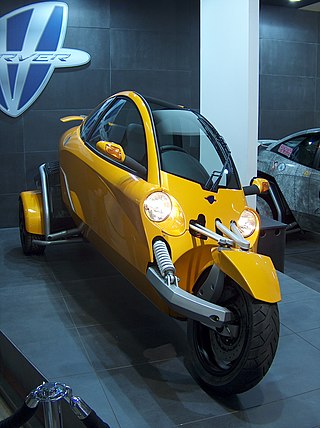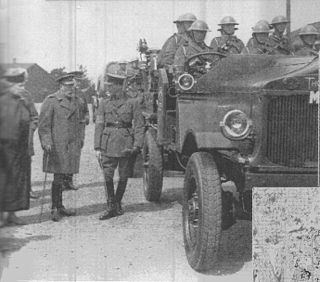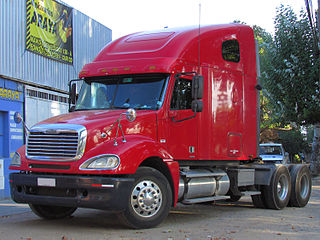
Suspension is the system of tires, tire air, springs, shock absorbers and linkages that connects a vehicle to its wheels and allows relative motion between the two. Suspension systems must support both road holding/handling and ride quality, which are at odds with each other. The tuning of suspensions involves finding the right compromise. It is important for the suspension to keep the road wheel in contact with the road surface as much as possible, because all the road or ground forces acting on the vehicle do so through the contact patches of the tires. The suspension also protects the vehicle itself and any cargo or luggage from damage and wear. The design of front and rear suspension of a car may be different.

A four-wheel drive, also called 4×4 or 4WD, is a two-axled vehicle drivetrain capable of providing torque to all of its wheels simultaneously. It may be full-time or on-demand, and is typically linked via a transfer case providing an additional output drive shaft and, in many instances, additional gear ranges.

In automotive design, a front-engine, front-wheel-drive (FWD) layout, or FF layout, places both the internal combustion engine and driven roadwheels at the front of the vehicle.

The 101 Forward Control or Land Rover 101FC was a light utility vehicle produced by Land Rover for the British Army. It was not available to the public off the production line, but was as military surplus.

A dump truck, known also as a dumping truck, dump trailer, dumper trailer, dump lorry or dumper lorry or a dumper for short, is used for transporting materials for construction as well as coal. A typical dump truck is equipped with an open-box bed, which is hinged at the rear and equipped with hydraulic rams to lift the front, allowing the material in the bed to be deposited ("dumped") on the ground behind the truck at the site of delivery. In the UK, Australia, South Africa and India the term applies to off-road construction plants only and the road vehicle is known as a tip lorry, tipper lorry, tipper truck, tip truck, tip trailer or tipper trailer or simply a tipper.
A swing axle is a simple type of independent suspension designed and patented by Edmund Rumpler in 1903. This was a revolutionary invention in automotive suspension, allowing driven (powered) wheels to follow uneven road surfaces independently, thus enabling the vehicle's wheels to maintain better road contact and holding; plus each wheel's reduced unsprung weight means their movements have less impact on the vehicle as a whole. The first automotive application was the Rumpler Tropfenwagen, later followed by the Mercedes 130H/150H/170H, the Standard Superior, the Volkswagen Beetle and its derivatives, the Chevrolet Corvair, and the roll-over prone M151 jeep amongst others.

A tilting three-wheeler, tilting trike, leaning trike, or even just tilter, is a three-wheeled vehicle and usually a narrow-track vehicle whose body and or wheels tilt in the direction of a turn. Such vehicles can corner without rolling over despite having a narrow axle track because they can balance some or all of the roll moment caused by centripetal acceleration with an opposite roll moment caused by gravity, as bicycles and motorcycles do. This also reduces the lateral acceleration experienced by the rider, which some find more comfortable than the alternative. The narrow profile can result in reduced aerodynamic drag and increased fuel efficiency. These types of vehicles have also been described as "man-wide vehicles" (MWV).

A drive wheel is a wheel of a motor vehicle that transmits force, transforming torque into tractive force from the tires to the road, causing the vehicle to move. The powertrain delivers enough torque to the wheel to overcome stationary forces, resulting in the vehicle moving forwards or backwards.

Six-wheel drive is an all-wheel drive drivetrain configuration of three axles with at least two wheels on each axle capable of being driven simultaneously by the vehicle's engine. Unlike four-wheel drive drivetrains, the configuration is largely confined to heavy-duty off-road and military vehicles, such as all-terrain vehicles, armored vehicles, and prime movers.

A tractor unit, also known as a truck unit, lorry unit, power unit, prime mover, ten-wheeler, semi-tractor, semi-truck, semi-lorry, tractor cab, truck cab, lorry cab, big rig tractor, big rig truck or big rig lorry or simply a tractor, truck, lorry, semi, big rig or rig, is a characteristically heavy-duty towing engine that provides motive power for hauling a towed or trailered load. These fall into two categories: heavy- and medium-duty military and commercial rear-wheel-drive semi-tractors used for hauling semi-trailers, and very heavy-duty typically off-road-capable, often 6×6, military and commercial tractor units, including ballast tractors.

The Tatra 148 was a truck produced in Czechoslovakia by the Tatra company.

An articulated hauler, articulated dump truck (ADT), or sometimes a dump hauler, is a very large heavy-duty type of dump truck used to transport loads over rough terrain, and occasionally on public roads. The vehicle usually has all-wheel drive and consists of two basic units: the front section, generally called the tractor, and the rear section that contains the dump body, called the hauler or trailer section. Steering is made by pivoting the front in relation to the back by hydraulic rams. This way, all wheels follow the same path, making it an excellent off-road vehicle.

The Scania 4-series low floor city bus and coach range was introduced by Scania in 1997 as a successor to the 3-series bus range.

Eight-wheel drive, often notated as 8WD or 8×8, is a drivetrain configuration that allows all eight wheels of an eight-wheeled vehicle to be drive wheels simultaneously. Unlike four-wheel drive drivetrains, the configuration is largely confined to heavy-duty off-road and military vehicles, such as armored vehicles, tractor units or all-terrain vehicles such as the Argo Avenger.

A tank transporter is a combination of a heavy tractor unit or a ballast tractor and a mating full trailer, hydraulic modular trailer or semi-trailer, used for transporting tanks and other armoured fighting vehicles. Some also function as tank recovery vehicles, the tractors of which may be armoured for protection in combat conditions.

The Thornycroft Hathi was an early four wheel drive lorry built by Thornycroft in the 1920s. It was used by the British Army as an artillery tractor.

Clément-Panhard is an automobile designed in 1898 by Arthur Constantin Krebs, manager of Panhard & Levassor co, from his 1896 patent of a car fitted with an electromagnetic gearbox, whose licence was acquired by Émile Levassor.

An H-drive drivetrain is a system used for heavy off-road vehicles with 6×6 or 8×8 drive to supply power to each wheel station.

A 6×4 or six-by-four is a vehicle with three axles, with a drivetrain delivering power to wheels at the ends of two of them. It is a form of four-wheel drive but not one of all-wheel drive.
This glossary of automotive terms is a list of definitions of terms and concepts related to automobiles, including their parts, operation, and manufacture, as well as automotive engineering, auto repair, and the automotive industry in general. For more specific terminology regarding the design and classification of various automobile styles, see Glossary of automotive design; for terms related to transportation by road, see Glossary of road transport terms; for competitive auto racing, see Glossary of motorsport terms.


















